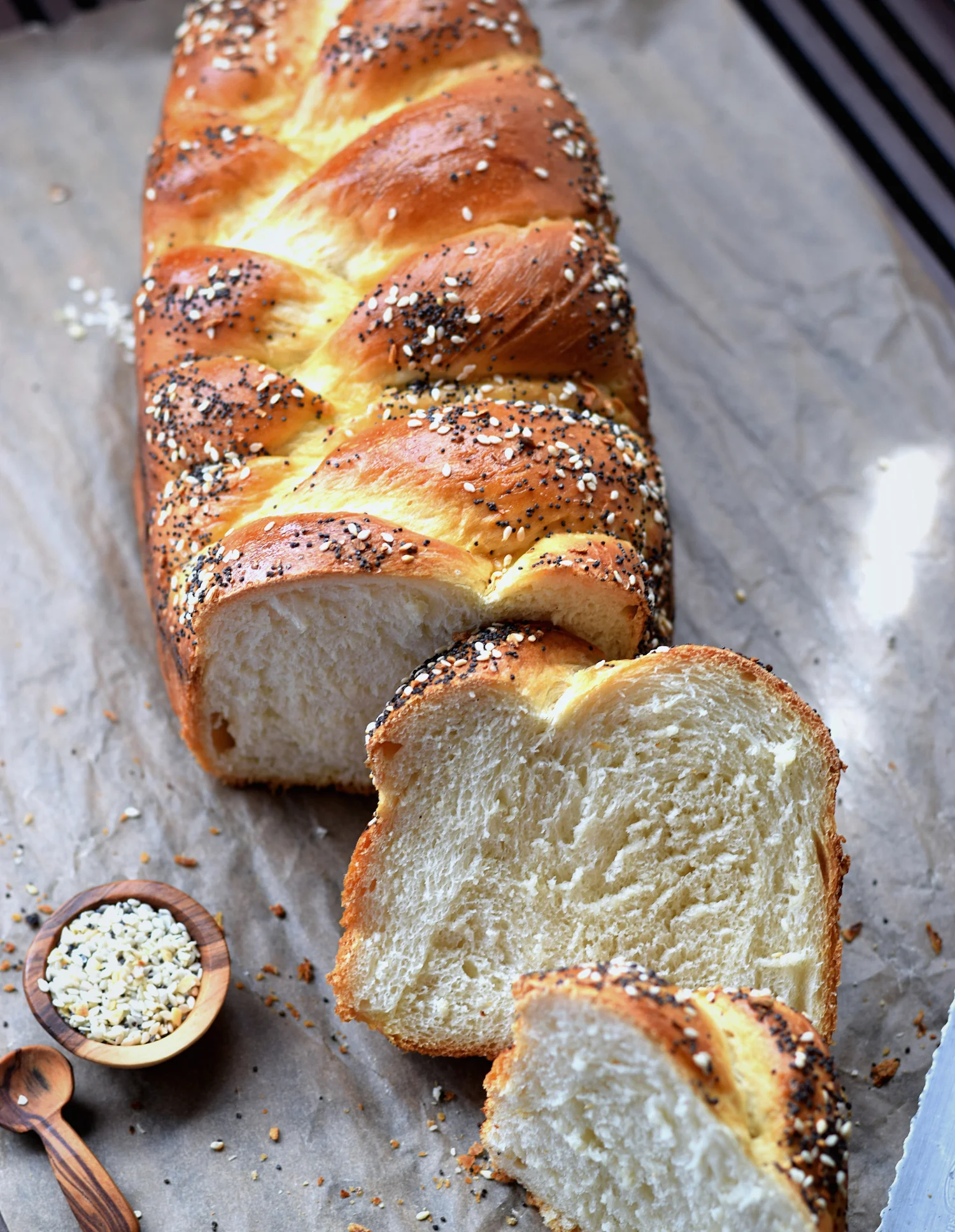Traditional Challah Bread + Video
Challah is one of my favorite foods of all time. Well, maybe not of all time, because as a kid, I didn't much appreciate this soft, fluffy, and rich bread. Now, I can't get enough of it.
And then they say people don't change. They're wrong, obviously. Because I love, love, LOVE challah.
Let's get technical for a minute here. Challah differs from other breads in a few ways. Aesthetically, it's unique because of its braided loaf shape. Ingredient-wise, challah usually has more eggs, sugar, and oil than a regular bread recipe. This is what gives challah its sweet, rich, amazing taste. A challah bread is also usually brushed with an egg wash before baking, which gives the challah its beautiful sheen.
Now, for the braiding. If you know how to braid your hair in a simple 3-strand, you know how to braid a challah. But if you want to get a little fancy, there's always a 4-braider, a 5-braider, a 6-braider, an 8-braider, a 16-braider (I'm just guessing now). And to learn some of these braiding techniques, look no further than right below. I created a short challah braiding video tutorial to help you get started on the process. Feel free to pause and replay certain parts of the video if it starts getting too confusing. I'd particularly recommend pausing at the 6-braider. Even I was confused. And I've done it 254 times. The 3 and 4-braiders are really easy. Really. Oh, and I even threw in a 2-strand twist as an extra bonus. Free of charge. Compliments of the chef. You're welcome.
So usually, there wouldn't be any leftovers after you make (this) challah. Here's why:
1. It's friggin uh-mazing.
2. It's friggin uh-mazing.
3. It's friggin uh-mazing.
Therefore, the recipe below is extra-large. You'll have more than enough for everyone to get seconds. And fifths. Invite your friends. Throw a challah party. This recipe uses an entire 5 LB. bag of flour, which produces a whopping 4 large braided loaves of bread.
Now, you can always cut the recipe down if you don't plan on throwing that challah party. I would suggest, however, to make the whole recipe, and then freeze 2-3 of the loaves for another time. These challot (Hebrew plural of challah) freeze wonderfully.
And if, somehow, you still have leftovers from the challah that you didn't freeze, make french toast. Duh. Challah was made for french toast - that is, of course, after it was made for being eaten fresh till stuffocation (yes, I made that word up, but it's good, no?).
Traditional Challah bread
Recipe slightly adapted from Glorious Creations Desserts
Yield: 4 large loaves
5 packets instant dry yeast (3 tablespoons)
1 1/2 cups sugar
4 1/2 cups warm water
5 LB. bread (high gluten) flour, + more for dusting table
3 whole eggs + 3 egg yolks
1 cup oil, + more for greasing bowl
3 tablespoons kosher salt (or 2 tablespoons regular salt)
1 egg, for brushing
Poppy or sesame seeds, optional
Place the yeast, then sugar in the bowl of your machine (or a regular bowl). Pour the warm water over the mixture. Cover the bowl with a towel and let the yeast sit 5-10 minutes, till it foams.
Once yeast is activated, place about half of your flour in the machine and begin mixing.
Once the flour is incorporated, add the eggs, oil, and salt to the machine. Mix.
Add the rest of the flour and let the machine knead the dough for a while (I do 12 minutes of kneading on medium speed in my machine).
The dough will be sticky. If it's REALLY sticky, add more flour.
Grease a large bowl with oil and place the dough into it. Flip the dough over so both sides get coated. Cover with a garbage bag (or towel) and let the dough rise in a warm spot till doubled in size, about 1 1/2 - 2 hours.
Once the dough is doubled in size, preheat oven to 350 F. Divide the dough into 4 sections and braid 4 large loaves (see video tutorial above). For simplest braid, roll out three equal strands of dough and connect/pinch them at the top. Proceed to braid the dough like you would your hair. Connect the strands at the bottom by pinching. You can also make rolls or any sized loaves you desire. Place the loaves on a lined sheet pan or in a greased loaf pan.
Cover the loaves with a towel and place them on the stove where the oven is pre-heating. Let the loaves rise again for 20-40 minutes, or until the loaves puff up and spread to the edges of the loaf pans. Brush the loaves with a beaten egg and, if desired, sprinkle with poppy seeds, sesame seeds, or both.
Bake for 45 minutes, until the challah takes on a beautiful golden-brown color. Remove loaves from their pans and line them on a rack to cool.
You can freeze these loaves in ziplock bags, eat them right away, or use them for french toast a few days later.
On a completely unrelated note, I guess I have a problem then (no, only joking):
Photo from dump a day dot com


















